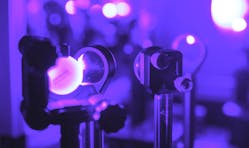Modern LED lights and solar panels owe their existence to advances in semiconductors that efficiently convert energy to light or vice versa. Now, next-generation semiconductors are on the horizon and, in a new study, researchers at the Georgia Institute of Technology have uncovered some of the eccentric physics behind their potential to again transform lighting and photovoltaics.
Comparing the quantum properties of these emerging so-called hybrid semiconductors with those of their established predecessors is tantamount to comparing the Bolshoi Ballet to jumping jacks. Twirling troupes of quantum particles undulate through the emerging materials, creating highly desirable optoelectronic (light-electronic) properties. These same properties are impractical for current semiconductors.
The particles moving through these new materials also include the material itself in the quantum action. Researchers were able to measure patterns in the material caused by quantum materials, then relate them both to the emerging material’s new properties and to energy introduced into the material.
Laser light in the visible range is processed so it can test quantum properties in materials. (Credit: Georgia Tech/Rob Felt)
The emerging material’s ability to house diverse, eccentric quantum particle movements is directly related to its unusual flexibility on a molecular level. By contrast, established semiconductors have rigid, straight-laced molecular structures.
The class of hybrid semiconductors the researchers examined is called halide organic-inorganic perovskite (HOIP). Beyond their promise of unique radiance and energy-efficiency, HOIPs are easy and inexpensive to produce and apply.
“HOIPs are made using lower temperatures and processed in solution,” says Carlos Silva, a Georgia Tech professor. “It takes much less energy to make them than current semiconductors, and you can make big batches.”
It takes high temperatures to make most semiconductors in small quantities, and they are rigid and difficult to put on surfaces. HOIPs, on the other hand, can be painted on to make LEDs, lasers, and even window glass that could glow in any color from aquamarine to fuchsia. Lighting with HOIPs may require little energy, and they could let solar-panel makers boost photovoltaics’ efficiency while slashing production costs.
The trick to getting a material to emit light is, broadly speaking, to apply energy to electrons in the material so that they can quantum leap up from their orbits around atoms, then emit that energy as light when they hop back down to orbits they had vacated. Established semiconductors trap electrons in areas of the material that strictly limit the electrons’ range of motion. Next, they apply energy to those areas to make electrons and emit useful light when they quantum hop back down in unison.
Carlos Silva (l) in his lab at Georgia Tech with graduate research assistant Félix Thouin examining a setup to process laser light in the visible range for the testing of quantum properties in a halide organic-inorganic perovskite. (Credit: Georgia Tech/Rob Felt)
There is a potentially better way to produce the light, and it is a core strength of the new hybrid semiconductors.
An electron has a negative charge, and an orbit it vacates after having been excited by energy is a positive charge called an electron hole. The electron and the hole can gyrate around each other forming a kind of imaginary particle, or quasiparticle, called an exciton.
“The positive-negative attraction in an exciton is called binding energy, and it’s a high-energy phenomenon, which makes it great for emitting light,” Silva says.
When the electron and the hole reunite, the binding energy is released and makes light. But excitons are usually hard to maintain in a semiconductor.
“The excitonic properties in conventional semiconductors are only stable at extremely cold temperatures,” Silva explains. “But in HOIPs, excitonic properties are stable at room temperature.”
Excitons get freed up from their atoms and move around the material. In addition, excitons in an HOIP can whirl around other excitons, forming quasiparticles called biexcitons.
Excitons also spin around atoms in the material lattice. In much the same way that an electron and an electron hole create an exciton, this twirl of the exciton around an atomic nucleus gives rise to yet another quasiparticle, a polaron. All that action can case excitons to transition back to polarons. Compounding all those dynamics is the fact that HOIPs are full of positively and negatively charged ions. And the quantum action has an overarching effect on the material itself.
The interactions between the materials’ atoms and the electrons, excitons, biexcitons, and polarons creates repetitive nanoscale indentations in the material that are observable as wave patterns that shift and flux with the amount of energy added to the material.
“In a ground state, these wave patterns would look a certain way, but with added energy, the excitons do things differently,” Silva says. “That changes the wave patterns, and that’s what we measure…The key observation in the study is that the wave pattern varies with different types of excitons (exciton, biexciton, polaronic/less polaronic).”
The indentations grip the excitons, slowing their mobility through the material, and these dynamics may affect the light being emitted.
The material, a halide organic-inorganic perovskite, is a sandwich of two inorganic crystal lattice layers with some organic material in between them. This makes HOIPs an organic-inorganic hybrid material. The quantum action happens in the crystal lattices.
The organic layer in between is like a sheet of rubber bands that makes the crystal lattices wobbly but stable. Also, HOIPs are put together with many non-covalent bonds, so the material is soft.
Individual units of the crystal take a form called perovskite, which is diamond shapes with a metal in the center, and halogens such as chlorine or iodine at the points—thus, “halide.”



